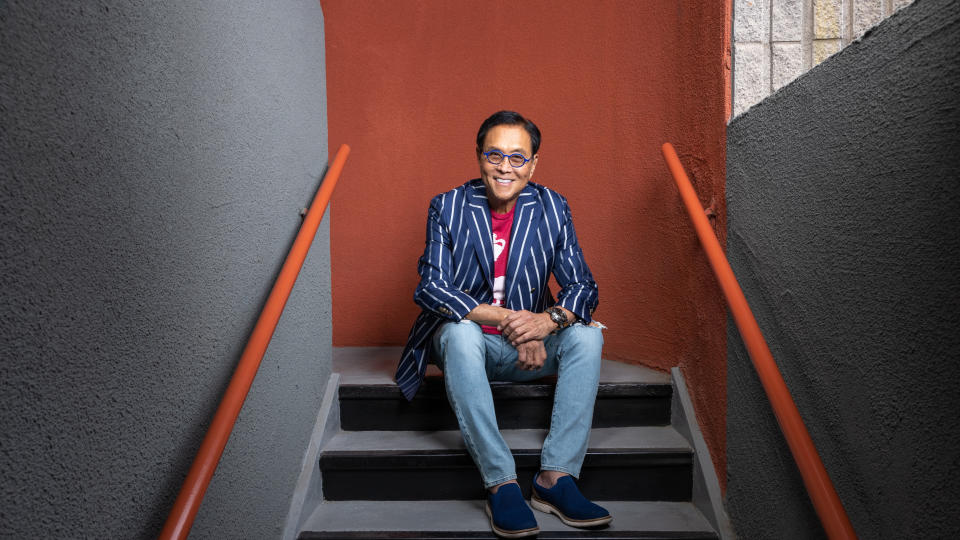Robert Kiyosaki: What Personal Cash Flow Looks Like for the Rich

Robert Kiyosaki, best known for his “Rich Dad, Poor Dad” book series, offers personal finance lessons that challenge conventional advice about saving money, investing for the long term and diversifying investments.
Check Out: Ramit Sethi: Track These 4 Numbers To Become a Millionaire
Discover More: 5 Unusual Ways To Make Extra Money (That Actually Work)
These insights involve understanding your cash flow and what you can do to gain financial freedom. Keep reading for Kiyosaki’s insights on the differences between how most of us handle our money and how the wealthy approach their finances, along with some strategies that lead to increased personal wealth.
Understanding Cash Flow Patterns
In “Rich Dad, Poor Dad,” Kiyosaki encourages people to examine their finances through a personal financial statement. This consists of an income statement and a balance sheet. On the income statement, you list income, such as paychecks and earned interest and expenses, such as rent, transportation costs, utilities and anything else you spend on each month.
On the balance sheet, you list your assets, such as investments or savings, and liabilities, such as debt or a mortgage. Kiyosaki says understanding how your income statement and balance sheet relate will help better picture your cash flow pattern.
How Most of Us Manage Our Money
Kiyosaki says most of us live “paycheck to paycheck,” meaning we have to spend money as fast as we earn it to cover our day-to-day expenses. While working-class people struggle more and often barely make enough to survive, the pattern isn’t much different among the middle class.
Learn More: 16 Tips To Live Well on a Low Salary, According to Dave Ramsey
While most middle-class people typically have higher-paying jobs, they have increased costs in the form of more expensive mortgages or higher car payments. In other words, their liabilities keep pace with their income, which means that they often have just as little money left at the end of the month as many working-class people.
Finance and Lifestyle
Those in the middle class tend to pursue lifestyles with increasing expenses, generally keeping pace with any promotions or job bonuses they may earn, and though they may seem to be doing better, they’re usually not in a better position than more working-class people — they just have nicer things and more of them.
According to Kiyosaki, another common middle-class trap is relying on credit to pay for these expenses. Instead of paying for their expenses with on-hand cash, they’ll delay the payments, only to owe more in the form of interest paid over time. Kiyosaki says this results in a “vicious cycle” of credit card debt that keeps the middle class living every bit as much “paycheck to paycheck” as those with lower-paying jobs.
How the Wealthy Generate Cash Flow
While working-class and middle-class people essentially trade their time and labor for cash, the wealthy approach earning differently. The title of the first chapter of Kiyosaki’s “Rich Dad, Poor Dad” is “The Rich Don’t Work for Money,” and according to Kiyosaki, understanding what that means is the secret to personal financial freedom.
While most people earn income through regular paychecks or other forms of “on-demand” income, the wealthy spend their money to acquire assets that generate passive income, freeing them up from the necessity of a daily nine-to-five job or hustling side gigs to make ends meet.
Kiyosaki says the rich make their money work for them. Instead of relying on jobs, the wealthy build assets that sustain or increase their cash flow without needing constant work.
Kiyosaki’s 3 Kinds of Income
Kiyosaki says there are three different types of income. The working- and middle-class go to work for earned income, exchanging their time for money. This is the first kind of income. Some may also pursue what Kiyosaki calls “portfolio income,” such as investing in the stock market. They may purchase stock at one price and hold it until they can sell it at a higher price.
However, the wealthy focus on a third type of revenue — passive income. They spend their time acquiring assets that generate income on their own, with no or very little effort required. Kiyosaki says the key to becoming wealthy is to pursue passive income opportunities.
Changing Your Personal Cash Flow Pattern
In essence, Kiyosaki says that to break free from the “rat race,” you need to pursue passive income by acquiring assets such as real estate or dividend-paying stocks that don’t require constant effort.
Though this may be easier said than done for most, it does give some guidance on how to maximize your personal potential and highlights some pitfalls to avoid, notably increasing consumption of more expensive goods and services as your personal spending power increases. While pursuing passive income may not be effortless, it is a worthwhile goal for those who have the option to consider it.
More From GOBankingRates
This article originally appeared on GOBankingRates.com: Robert Kiyosaki: What Personal Cash Flow Looks Like for the Rich
